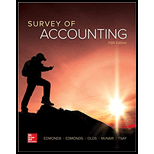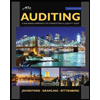
SURVEY OF ACCOUNTING(LL)>CUSTOM PKG.<
5th Edition
ISBN: 9781264010653
Author: Edmonds
Publisher: MCGRAW-HILL HIGHER EDUCATION
expand_more
expand_more
format_list_bulleted
Concept explainers
Textbook Question
Chapter 1, Problem 31P
Problem 1-30A Classifying events as asset source, use, or exchange
The following unrelated events are typical of those experienced by business entities:
- 1. Acquire cash by issuing common stock.
- 2. Pay other operating supplies expense.
- 3. Agree to represent a client in an IRS audit and to receive payment when the audit is complete.
- 4. Receive cash from customers for services rendered.
- 5. Pay employee salaries with cash.
- 6. Pay back a bank loan with cash.
- 7. Pay interest to a bank with cash.
- 8. Transfer cash from a checking account to a
money market account. - 9. Sell land for cash at its original cost.
- 10. Pay a cash dividend to stockholders.
- 11. Learn that a financial analyst determined the company’s price-earnings ratio to be 26.
- 12. Borrow cash from the local bank.
- 13. Pay office supplies expense.
- 14. Make plans to purchase office equipment.
- 15. Trade a used car for a computer with the same value.
Required
Identify each of the events as an asset source, use, or exchange transaction. If an event would not be recorded under generally accepted accounting principles, identify it as not applicable (NA). Also indicate for each event whether total assets would increase, decrease, or remain unchanged. Organize your answer according to the following table. The first event is shown in the table as an example.
| Event No. | Type of Event | Effect on Total Assets |
| 1 | Asset source | Increase |
Expert Solution & Answer
Want to see the full answer?
Check out a sample textbook solution
Students have asked these similar questions
Which is not an objective of internal controls?A. Safeguard assetsB. Improve profitsC. Ensure accurate recordsD. Promote operational efficiencyneed help
Which is not an objective of internal controls?A. Safeguard assetsB. Improve profitsC. Ensure accurate recordsD. Promote operational efficiencyno ai
Can you solve this general accounting problem using appropriate accounting principles?
Chapter 1 Solutions
SURVEY OF ACCOUNTING(LL)>CUSTOM PKG.<
Ch. 1 - Prob. 1QCh. 1 - Prob. 2QCh. 1 - Prob. 3QCh. 1 - 4. In a business context, what does the term...Ch. 1 - 5. What market trilogy components are involved in...Ch. 1 - 6. Give an example of a financial resource, a...Ch. 1 - Prob. 7QCh. 1 - 8. How do financial and managerial accounting...Ch. 1 - Prob. 9QCh. 1 - Prob. 10Q
Ch. 1 - Prob. 11QCh. 1 - 12. Distinguish between elements of financial...Ch. 1 - Prob. 13QCh. 1 - 14. To whom do the assets of a business belong?Ch. 1 - 15. Describe the differences between creditors and...Ch. 1 - Prob. 16QCh. 1 - Prob. 17QCh. 1 - Prob. 18QCh. 1 - 19. What does a double-entry bookkeeping system...Ch. 1 - 22. How does acquiring capital from owners affect...Ch. 1 - Prob. 21QCh. 1 - Prob. 22QCh. 1 - 25. What are the three primary sources of assets?Ch. 1 - 26. What is the source of retained earnings?Ch. 1 - 27. How does distributing assets (paying...Ch. 1 - 28. What are the similarities and differences...Ch. 1 - Prob. 27QCh. 1 - 30. Which of the general-purpose financial...Ch. 1 - 31. What causes a net loss?Ch. 1 - 35. What three categories of cash receipts and...Ch. 1 - Prob. 31QCh. 1 - 37. Discuss the term articulation as it relates to...Ch. 1 - 38. How do temporary accounts differ from...Ch. 1 - Prob. 34QCh. 1 - 41. Identify the three types of accounting...Ch. 1 - Prob. 36QCh. 1 - Prob. 37QCh. 1 - Prob. 1ECh. 1 - Prob. 2ECh. 1 - Exercise 1-3A Identifying the reporting entities...Ch. 1 - Exercise 1-4A Define Terms and Identify Missing...Ch. 1 - Exercise 1-5 Effect of events on the accounting...Ch. 1 - Exercise 1-6 Effect of transactions on general...Ch. 1 - Exercise 1-7 Missing information and recording...Ch. 1 - Prob. 8ECh. 1 - Exercise 1-9A Record events and interpret...Ch. 1 - Exercise 1-10 Interpreting the accounting equation...Ch. 1 - Prob. 11ECh. 1 - Exercise 1-12A Differences between interest and...Ch. 1 - Exercise 1-13A Classifying events as asset source,...Ch. 1 - Prob. 14ECh. 1 - Exercise 1-15 Preparing an income statement and a...Ch. 1 - Prob. 16ECh. 1 - Prob. 17ECh. 1 - Prob. 18ECh. 1 - Prob. 19ECh. 1 - Riley Company paid 60,000 cash to purchase land...Ch. 1 - Prob. 21ECh. 1 - As of January 1, 2018, Room Designs, Inc. had a...Ch. 1 - As of December 31, 2018, Flowers Company had total...Ch. 1 - Prob. 24ECh. 1 - Critz Company was started on January 1, 2018....Ch. 1 - The Candle Shop experienced the following events...Ch. 1 - Prob. 27ECh. 1 - Prob. 28PCh. 1 - Prob. 29PCh. 1 - Match the terms (identified as a through r) with...Ch. 1 - Problem 1-30A Classifying events as asset source,...Ch. 1 - Problem 1-31A Relating titles and accounts to...Ch. 1 - Marks Consulting experienced the following...Ch. 1 - Prat Corp. started the 2018 accounting period with...Ch. 1 - Maben Company was started on January 1, 2018, and...Ch. 1 - Required Use the Target Corporations Form 10-K to...Ch. 1 - ATC 1-5 Writing Assignment Elements of financial...
Knowledge Booster
Learn more about
Need a deep-dive on the concept behind this application? Look no further. Learn more about this topic, accounting and related others by exploring similar questions and additional content below.Similar questions
- Which is not an objective of internal controls?A. Safeguard assetsB. Improve profitsC. Ensure accurate recordsD. Promote operational efficiency no aiarrow_forwardPlease provide the accurate answer to this financial accounting problem using appropriate methods.arrow_forwardI am searching for the accurate solution to this financial accounting problem with the right approach.arrow_forward
- 20 Nelson and Murdock, a law firm, sells $8,000,000 of four-year, 8% bonds priced to yield 6.6%. The bonds are dated January 1, 2026, but due to some regulatory hurdles are not issued until March 1, 2026. Interest is payable on January 1 and July 1 each year. The bonds sell for $8,388,175 plus accrued interest. In mid-June, Nelson and Murdock earns an unusually large fee of $11,000,000 for one of its cases. They use part of the proceeds to buy back the bonds in the open market on July 1, 2026 after the interest payment has been made. Nelson and Murdock pays a total of $8,456,234 to reacquire the bonds and retires them. Required1. The issuance of the bonds—assume that Nelson and Murdock has adopted a policy of crediting interest expense for the accrued interest on the date of sale.2. Payment of interest and related amortization on July 1, 2026.3. Reacquisition and retirement of the bonds.arrow_forward13 Which of the following is correct about the difference between basic earnings per share (EPS) and diluted earnings per share? Question 13 options: Basic EPS uses comprehensive income in its calculation, whereas diluted EPS does not. Basic EPS is not a required disclosure, whereas diluted EPS is required disclosure. Basic EPS uses total common shares outstanding, whereas diluted EPS uses the weighted-average number of common shares. Basic EPS is not adjusted for the potential dilutive effects of complex financial structures, whereas diluted EPS is adjusted.arrow_forwardPlease explain the solution to this general accounting problem with accurate explanations.arrow_forward
- I need guidance with this financial accounting problem using the right financial principles.arrow_forwardGeneral Accounting Question Solutionarrow_forwardWhich is not an objective of internal controls?A. Safeguard assetsB. Improve profitsC. Ensure accurate recordsD. Promote operational efficiencyarrow_forward
arrow_back_ios
SEE MORE QUESTIONS
arrow_forward_ios
Recommended textbooks for you
 Intermediate Accounting: Reporting And AnalysisAccountingISBN:9781337788281Author:James M. Wahlen, Jefferson P. Jones, Donald PagachPublisher:Cengage Learning
Intermediate Accounting: Reporting And AnalysisAccountingISBN:9781337788281Author:James M. Wahlen, Jefferson P. Jones, Donald PagachPublisher:Cengage Learning Survey of Accounting (Accounting I)AccountingISBN:9781305961883Author:Carl WarrenPublisher:Cengage Learning
Survey of Accounting (Accounting I)AccountingISBN:9781305961883Author:Carl WarrenPublisher:Cengage Learning Auditing: A Risk Based-Approach to Conducting a Q...AccountingISBN:9781305080577Author:Karla M Johnstone, Audrey A. Gramling, Larry E. RittenbergPublisher:South-Western College Pub
Auditing: A Risk Based-Approach to Conducting a Q...AccountingISBN:9781305080577Author:Karla M Johnstone, Audrey A. Gramling, Larry E. RittenbergPublisher:South-Western College Pub

Intermediate Accounting: Reporting And Analysis
Accounting
ISBN:9781337788281
Author:James M. Wahlen, Jefferson P. Jones, Donald Pagach
Publisher:Cengage Learning

Survey of Accounting (Accounting I)
Accounting
ISBN:9781305961883
Author:Carl Warren
Publisher:Cengage Learning

Auditing: A Risk Based-Approach to Conducting a Q...
Accounting
ISBN:9781305080577
Author:Karla M Johnstone, Audrey A. Gramling, Larry E. Rittenberg
Publisher:South-Western College Pub
The ACCOUNTING EQUATION For BEGINNERS; Author: Accounting Stuff;https://www.youtube.com/watch?v=56xscQ4viWE;License: Standard Youtube License